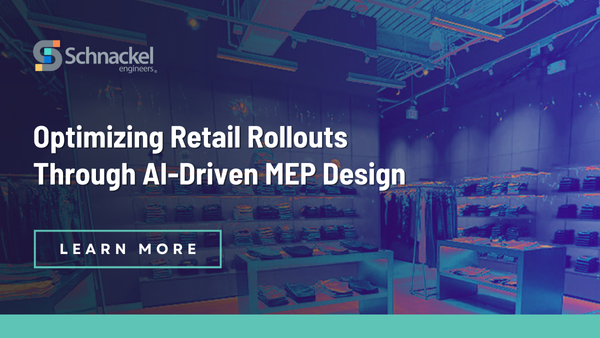Optimizing Retail Rollouts Through AI‑Driven MEP Design

Retail rollouts are key for rapidly expanding a brand’s presence across multiple locations. However, managing MEP (Mechanical, Electrical, and Plumbing) systems for these projects can be complex, especially with tight deadlines, varying site conditions, and the need for consistency across all stores. Ensuring that each location is functional, energy-efficient, and cost-effective requires precision, collaboration, and an optimized approach to MEP design.
AI-driven MEP design is transforming the way MEP engineers approach these challenges. By automating routine tasks, optimizing system designs, and simulating real-time data, AI is helping streamline the design and implementation of MEP systems across retail rollouts. This technology enables faster, more accurate, and sustainable designs, helping retailers meet their expansion goals while reducing upfront costs, improving efficiency and meeting sustainability goals.
Let’s dive into the specific ways AI-driven MEP design optimizes retail rollout design.
What is a Retail Rollout?
A retail rollout is the strategic and planned process of expanding a retail business by opening or remodeling multiple store locations. It’s a planned process focused on delivering a consistent brand experience and efficient operations across all locations. Achieving this requires tight collaboration between teams – from leasing departments, architects, and contractors to MEP engineers – ensuring each new or remodeled store is fully operational on time, meets brand specifications, and is set up for optimal long-term performance.
What is AI-Driven MEP Design?
AI-driven MEP design leverages artificial intelligence to automate and optimize the design, simulation, and implementation of MEP systems. By utilizing advanced algorithms, AI tools analyze vast amounts of data to help engineers make smarter, faster, and better decisions. These tools can automate complex calculations, simulate various configurations, and provide real-time feedback, improving the speed and accuracy of the design process.
In retail rollouts, AI-driven MEP design ensures that MEP systems are customized to the specific needs of each store, reducing design and construction costs, optimizing energy efficiency, operational performance, and overall cost-effectiveness from cradle to grave.
By integrating AI into every phase of MEP planning, retailers gain measurable advantages in efficiency, speed, and cost. The next sections highlight the key ways AI‑driven MEP design delivers these results.
1. Optimizing MEP Systems for Better, More Efficient Designs
One of the most significant benefits of AI‑driven MEP design is its ability to optimize MEP systems for initial cost, energy efficiency, and performance. AI simulates various system configurations to identify the most cost effective and sustainable solutions. It ensures that HVAC, lighting, and plumbing systems are not only energy efficient but also tailored to the specific operational needs of each location, with clean, elegant layouts that integrate seamlessly into the space. This results in designs that reduce construction costs, utility costs, improve system performance, and contribute to the long term sustainability of retail operations.
2. Speeding up the Design Process and Accelerating Project Timelines
Retail rollouts come with very tight, critical deadlines. AI‑driven MEP design speeds up every phase of the project. By automating system calculations, load analyses, routing, and sizing, AI compresses days of design work into minutes, reducing human error and producing accurate, code‑ready plans that move quickly through permitting. Early clash detection allows rapid adjustments before construction begins, avoiding costly delays on‑site. This rapid turnaround is crucial for retail rollouts, where speed‑to‑market offers a decisive competitive advantage and keeps each store opening on schedule. Design delivery schedules are measured in days, instead of weeks or months.
3. Enhancing Accuracy and Minimizing Design Errors
With traditional design methods, even minor mistakes can lead to costly setbacks, delays, and cost overruns. AI-driven MEP design greatly improves accuracy by running simulations and analyzing design data in real time. This technology helps identify potential errors or inefficiencies before construction begins, reducing the need for rework during the build phase. AI-driven solutions ensure that designs are precise and optimized for performance, which improves reliability and minimizes the chance of delays due to errors.
4. Better Coordinated Designs
Better design coordination is possible because the MEP engineers are not busy doing laborious sizing calculations and routing decisions conventionally. By automating these time consuming tasks, MEP engineers have more time to coordinate with the architect and the owner to achieve the overall project objectives and aesthetic goals. The aesthetics of the design take center stage since the systems behind the scenes are handled by the AI automation. The result is a better brand image and a better customer experience.
5. Reducing Costs through Automation and Optimization
AI-driven MEP design automates complex tasks, reducing fees and freeing engineers to focus on higher-level problem-solving and providing more time for aesthetics and coordination. AI designed systems cost substantially less to construct than traditional human generated designs. Also, by optimizing MEP systems for energy efficiency and operational effectiveness, AI helps reduce long-term costs, especially in terms of energy consumption. Shorter, more accurate routes results in less energy consumption over the life of the facility. Furthermore, automating the design process reduces the need for field revisions, saving time and resources during construction. This leads to cost savings in both the short and long term, making retail rollouts more budget-friendly while still meeting high standards of design.
Conclusion
AI-driven MEP design is revolutionizing the retail rollout process by providing faster, more accurate, and more efficient solutions. From optimizing MEP systems for construction cost, energy efficiency, and sustainability to speeding up design timelines, improving accuracy, and reducing field changes, AI is helping retailers meet their expansion goals while keeping projects on track and within budget.
At Schnackel Engineers, we leverage our proprietary AI for MEP® design technology to deliver optimized, energy-efficient solutions for all retail and restaurant rollout programs. Our decades of experience, combined with the power of AI, enable us to help our clients streamline their retail expansions, ensuring each new store meets operational and sustainability goals while staying on time and within budget.
Contact Schnackel Engineers today to learn how our AI-driven MEP design can enhance your next retail rollout and help you achieve success with greater efficiency and precision.
Comments